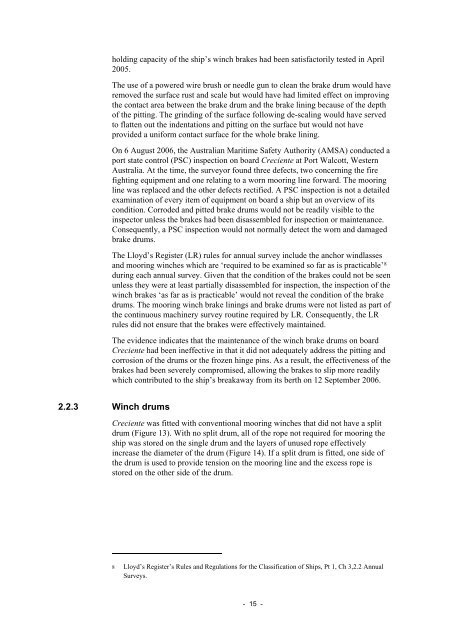Marine Occurrence report 232 - Australian Transport Safety Bureau
Marine Occurrence report 232 - Australian Transport Safety Bureau
Marine Occurrence report 232 - Australian Transport Safety Bureau
You also want an ePaper? Increase the reach of your titles
YUMPU automatically turns print PDFs into web optimized ePapers that Google loves.
holding capacity of the ship’s winch brakes had been satisfactorily tested in April<br />
2005.<br />
The use of a powered wire brush or needle gun to clean the brake drum would have<br />
removed the surface rust and scale but would have had limited effect on improving<br />
the contact area between the brake drum and the brake lining because of the depth<br />
of the pitting. The grinding of the surface following de-scaling would have served<br />
to flatten out the indentations and pitting on the surface but would not have<br />
provided a uniform contact surface for the whole brake lining.<br />
On 6 August 2006, the <strong>Australian</strong> Maritime <strong>Safety</strong> Authority (AMSA) conducted a<br />
port state control (PSC) inspection on board Creciente at Port Walcott, Western<br />
Australia. At the time, the surveyor found three defects, two concerning the fire<br />
fighting equipment and one relating to a worn mooring line forward. The mooring<br />
line was replaced and the other defects rectified. A PSC inspection is not a detailed<br />
examination of every item of equipment on board a ship but an overview of its<br />
condition. Corroded and pitted brake drums would not be readily visible to the<br />
inspector unless the brakes had been disassembled for inspection or maintenance.<br />
Consequently, a PSC inspection would not normally detect the worn and damaged<br />
brake drums.<br />
The Lloyd’s Register (LR) rules for annual survey include the anchor windlasses<br />
and mooring winches which are ‘required to be examined so far as is practicable’ 8<br />
during each annual survey. Given that the condition of the brakes could not be seen<br />
unless they were at least partially disassembled for inspection, the inspection of the<br />
winch brakes ‘as far as is practicable’ would not reveal the condition of the brake<br />
drums. The mooring winch brake linings and brake drums were not listed as part of<br />
the continuous machinery survey routine required by LR. Consequently, the LR<br />
rules did not ensure that the brakes were effectively maintained.<br />
The evidence indicates that the maintenance of the winch brake drums on board<br />
Creciente had been ineffective in that it did not adequately address the pitting and<br />
corrosion of the drums or the frozen hinge pins. As a result, the effectiveness of the<br />
brakes had been severely compromised, allowing the brakes to slip more readily<br />
which contributed to the ship’s breakaway from its berth on 12 September 2006.<br />
2.2.3 Winch drums<br />
Creciente was fitted with conventional mooring winches that did not have a split<br />
drum (Figure 13). With no split drum, all of the rope not required for mooring the<br />
ship was stored on the single drum and the layers of unused rope effectively<br />
increase the diameter of the drum (Figure 14). If a split drum is fitted, one side of<br />
the drum is used to provide tension on the mooring line and the excess rope is<br />
stored on the other side of the drum.<br />
8 Lloyd’s Register’s Rules and Regulations for the Classification of Ships, Pt 1, Ch 3,2.2 Annual<br />
Surveys.<br />
- 15 -
















